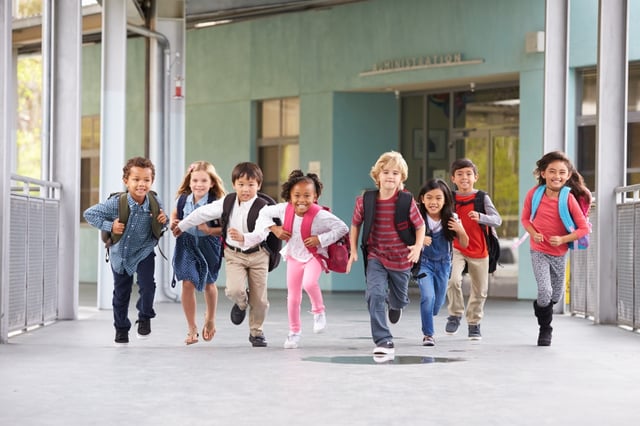
For students, Winter break is exciting! For teachers, Winter break is essential.
Burnout is real and having that mid-year mini vacation to reset your brain, refresh your spirit, and reinvigorate your love for teaching can make the world of difference for both you and your students! But what about when the break is over? No one makes paper-chain countdowns for the first day back to school in January.
Even if you’re ready to get back in the saddle, getting your students back into their daily routine after a lapse can be difficult to say the least. While you may feel unsure of how to approach those first days back, that often tough transition can actually be a hidden blessing; providing you with an opportunity to re-engage your students in deeper and more meaningful ways than before!
Here are ten ways you can seize that opportunity, and re-engage students after Winter break!
Have a Second “First Day”
My first year teaching, I was hired after the school year had already begun, and I really struggled to engage my students after they had already become accustomed to weeks of rotating substitutes and loose expectations. I remember lamenting the fact that I didn’t begin the school year with my students to my mentor teacher, who told me with a smile “It’s never too late to start over!”
How to do it:
When students enter your classroom, treat them just as you would for the first day of school. Greet them at the door, and have directions ready for seating and bell-work as they wait for class to begin. When class starts, review classroom expectations, implement procedure changes, and set any new ground rules. Finish the class with a fun ice-breaker game to get their brain juices flowing again!
Why it works:
When your students first entered your classroom at the beginning of the year, they had very little idea of what to truly expect. You set the tone, and they followed suit. Winter break provides just enough separation that you can, once again, set the tone for how things will be for the rest of the year. Students will be looking to you for what to expect, and what is expected of them.
Start Slow & Prioritize
The most difficult part is behind you! After being re-energized by a break and making a fresh set of lessons, it can be tempting to jump full-force into all your new and exciting plans. Instead, give you and your students time to adjust and get back in the groove before trying to reach all of your new goals right away.
How to do it:
When reviewing the content you are going to be covering, focus on the “nuts and bolts”. Look for information that is important for your students, and make a list. Then look through your finished list and prioritize the concepts from most to least important. Plan on developing lesson plans that focus on just one or two of the most important concepts, & anything else is a bonus! Repeat those most important themes a few times before incorporating something new. Be kind to yourself and allow room for flexibility in your schedule in case some concepts take a little more or less time than you expect.
Why it works:
By prioritizing key concepts and setting attainable goals you can avoid “back to school burnout” and build classroom confidence. Separating the “important” from the “most important” will allow your lessons to become more focused. Your students will be able to find success through mastery of major “umbrella” concepts that overhang smaller concepts and pave the way for future learning throughout the rest of the year. Success breeds success and students will become more invested in lessons they feel they can do well in.
Create New Year’s Resolutions
This fun tradition can be the perfect transition into the new year! Many students will be familiar with the concept of New Year’s Resolutions, and this “real world” connection of goal-setting will be both fun and productive!
How to do it:
Work with your students to create some attainable “New Year’s Resolutions”. These can be personal goals that they create individually, group goals they create as teams, or whole-class goals that work for everyone. Write these goals out, discuss concrete plans for how those goals will be met, and the timeline of when you’d like to meet them. Hang your resolutions somewhere they can be seen (individual goals can be placed on desks, or in the front sleeve of a binder) and provide daily reminders of your game plan. Be sure to mark-off progress visually, and celebrate achievements throughout!
Why it works:
Goal-setting makes the learning process personal, and provides concrete markers for success. Holidays are associated with fun, so simply connecting New Year’s Eve to goal-setting by calling them resolutions can automatically make the concept more interesting and fun. Allowing students to be a part of the process creates ownership.
Be Relevant
Winter break provides an opportunity for students to use their free-time in a way that is interesting and attractive to them. Coming back to school and engaging in learning can seem like hard work and unappealing- with no meaningful connections to the “real” outside world they were just immersed in over break.
How to do it:
The easiest way to make your lessons relevant is to simply be aware of what’s happening in the world around you; or more specifically, the world around your students. Take note of pop-culture, new technology, and trending topics on social media. Find ways, to integrate them into your daily lessons and students will light-up at discovering these “Easter Eggs” integrated into their school life.
Why it works:
Our brains love the feeling of making connections! It’s what makes jokes funny, or solving a problem so satisfying. By taking something that students already appreciate, and applying it to something like a word problem or science experiment, you are automatically giving students that happy association and joy of making a connection. They will look for these positive moments in your lesson plans which will automatically become more interesting and engaging because of those relevant connections.
Remember Where You’ve Been
The advantage of the second half of the year is that a lot of ground has already been covered, and you and your students have the opportunity to move forward stronger than before! There may be things that are familiar to students such as certain routines or familiar concepts that can act as anchors to keep students on-track and engaged.
How to do it:
Take some time for an honest reflection of what was/wasn’t successful in your classroom the first half of the school year. Now that you’ve had a chance to get to know your students, their strengths and weaknesses, likes and dislikes, etc… you can create an environment that sets them up for success. Remind students of what they’ve already learned, and the expectations and rules they already know.
Why it works:
While the return from break can be a fresh start, the familiar can be comforting- so if something was working before break, don’t abandon it! Students will greet those moments with an attitude of “I’ve been here before, I know what I need to do.” And that positive attitude can empower your class to begin the new calendar year with confidence.
However you plan to engage your students after break, enjoy your fresh start and make time for opportunities to have fun and connect with your students! Happy New Year from ESCOT Bus Lines!
More great FL teacher resources from Escot Bus Lines-
- Great Orlando Field Trip Ideas
- Fun Field Trip Ideas in Tampa
- Top 10 Best Websites for Teachers
- Field Trip Chaperone Checklist

